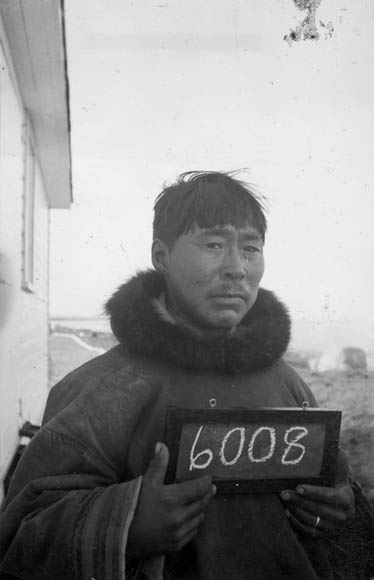Inuvialuit originally occupied the western Canadian arctic coast from Barter Island in the west to Cape Bathurst in the east, as well as the northern portion of the Mackenzie River Delta. Numbering about 2000 during the 19th century, they formed the densest Inuit population in arctic Canada. They were divided into five regional groups of 200-1000, each with a way of life adapted to the resources of its own area. The group west of the Mackenzie River spent the summer fishing and hunting caribou, and the winter sealing; those at Cape Bathurst in the east hunted the large bowhead whale during the summer and seals during the winter.
The largest group lived in the Mackenzie Delta, centered at the village of Kittigazuit at the mouth of the main river channel. Here, people gathered during the summer to hunt beluga feeding in the shallow estuary. The area was a natural trap for beluga, which were driven upstream onto shoals by groups of up to 200 hunters in kayaks; a single hunt might kill several hundred small whales, providing food and fuel for winter use.
The remainder of the year was spent in fishing, hunting caribou and sealing. During winter the people moved to smaller settlements of a few houses each. Winter houses were built of driftwood logs, heavily banked with turf insulation, heated and lighted by stone or pottery lamps burning whale oil, and each accommodated about six families. Social organization was family-based; most marriages were monogamous, although polygamy was practised by wealthy individuals. Families or individuals owned such items as houses, tents, kayaks and umiaks. There is some evidence that the regional groups had hereditary chiefs, with the office passed through the male line. Little is known about the Aboriginal religion, but it was based on shamanism, and important religious festivities occurred when the population gathered during the period of total darkness in December.
Archaeology indicates that the ancestors of the Inuvialuit have lived in the area for approximately 1000 years, having derived from a Thule population that moved eastward from Alaska about 1000 AD. Through the following centuries they maintained trading and cultural ties with the Alaskan Inuit to the west, and were the most easterly group to share in the relatively rich Alaskan Inuit way of life. The Mackenzie Inuit became involved in the European fur trade during the 19th century, at first by indirect trade with the Russian posts in Alaska and later with posts established in the Mackenzie Delta.
During the late 19th century they became heavily involved with the American whalers who began to hunt and winter in the area. Because of a series of epidemic diseases, their population had been reduced to less than 10% of Aboriginal levels by 1900, and their territory had been largely taken over by Alaskan Inuit and Europeans who moved into the area as trappers. The descendants of the Inuvialuit now live in the communities of Ikaahuk (Sachs Harbour), Inuvik, Tuktuujaqtuuq (Tuktoyaktuk) and Paulatuuq (Paulatuk). The Inuvialuit negotiated a comprehensive land claim agreement with the government of Canada in 1984.
See also Aboriginal People: Arctic.

 Share on Facebook
Share on Facebook Share on X
Share on X Share by Email
Share by Email Share on Google Classroom
Share on Google Classroom







